Trina Spillman's Blog, page 2
May 30, 2020
Magick or Miracle?

Some believe magick is the manipulation of the natural energies that surround us. Practitioners of magick use this energy to focus one’s intention in order to manifest a deep desire. So how is this different from praying? Repeating a chant and using prayer beads to tap into the surrounding energies allows one to focus on a deep desire. Some call such a desire a prayer. So why is it socially permissible to say “I’m going to go pray”, but throughout history, saying something along the lines of, “I’m going to go cast a spell,” has resulted in being burned at the stake? For that, we’ll have to travel back to the advent of religion.
“He who controls the religion, controls the region”
This has been a basic tenant of conquerors and rulers for centuries. One could argue the Roman Empire never really fell, but rather morphed into what we now know as The Holy See. Throughout history, religion has been used to establish norms in order to control an otherwise superstitious and unruly population. But as in any society, there were those that marched to the tune of a different drummer and had no intention of following “religious” teachings. These groups worshiped nature, not a man.
In order to control these alleged “dissidents,” a propaganda war against witches, druids, and yes, magick, was launched, resulting in multiple belief systems, rooted in the laws of nature, being forced under ground.
Today
While no longer burned at the stake, modern day practitioners of magick still experience scorn and ridicule. Casting spells using herbs, essential oils and candles do not make the practitioners of magick evil. After all, didn’t Jesus turn water into wine?
Practitioners of magic observe the law of three. Put simply, the practitioner will get back three times what they put into the spell. A spell or intention that is meant to do harm uses negative energy and will return three times the negative energy. By contrast, if positive energy is used in creating a spell or prayer, positive energy is received. Better known concept? Instant karma.
Magick is a common theme in the new book The Fablecastle Chronicles. There is more to the story. Can you handle the truth about how it all began?
The post Magick or Miracle? appeared first on Trina Spillman Author.
Magic or Miracle?

Some believe magic is the manipulation of the natural energies that surround us. Practitioners of magic use this energy to focus one’s intention in order to manifest a deep desire. So how is this different from praying? Repeating a chant and using prayer beads to tap into the surrounding energies, allows one to focus on a deep desire; a prayer. So why is it socially permissible to say “I’m going to go pray”, but throughout history, saying something along the lines of, “I’m going to go cast a spell,” has resulted in being burned at the stake? For that, we’ll have to travel back to the advent of religion.
“He who controls the religion, controls the region”
This has been a basic tenant of conquerors and rulers for centuries. One could argue the Roman Empire never really fell, but rather morphed into what we now know as The Holy See. Throughout history, religion has been used to establish norms in order to control an otherwise superstitious and unruly population. But as in any society, there were those that marched to the tune of a different drummer and had no intention of following “religious” teachings. These groups worshiped nature, not a man.
In order to control these alleged “dissidents,” a propaganda war against witches, druids, and yes, magic, was launched, resulting in multiple belief systems, rooted in the laws of nature, being forced under ground.
Today
While no longer burned at the stake, modern day practitioners of magic still experience scorn and ridicule. Casting spells for good using herbs, essential oils and candles do not make the practitioners of magic evil. After all, didn’t Jesus turn water into wine?
Practitioners of magic observe the law of three. Put simply, the practitioner will get back three times what they put into the spell. A spell or intention that is meant to do harm uses negative energy and will return three times the negative energy. By contrast, if positive energy is used in creating a spell or prayer, positive energy is received. Better known concept? Instant karma.
Magic is a common theme in the new book The Fablecastle Chronicles. There is more to the story.
The post Magic or Miracle? appeared first on Trina Spillman Author.
May 17, 2020
Ghostly Sentries Stand Guard
 History
HistoryFort Zachary Taylor, named after President Zachary Taylor, is located in Key West, Florida. At the outset of the U.S. Civil War in 1861, Union Captain John Milton Brannan seized control of the fort, preventing it from falling into Confederate hands. Originally, the fort was surrounded by water on all sides, with a walkway linking it to the mainland. The fort was completed in 1866, although the upper level of one side was destroyed in 1889 to make way for more modern weapons, with the older cannons being buried within the new outer wall to save on materials. This stash of cannons would later become a significant historical find. The fort was heavily used again during the 1898 Spanish-American War and, in 1947, the fort, no longer of use to the Army, was turned over to the U.S. Navy for maintenance.
Today
Today, in addition to the roles of the fort and its adjacent beach as tourist attractions, Fort Taylor is also the location of a number of annual events, including several-weeks-long Civil War reenactments; and on the weekend preceding Halloween, it is transformed into a haunted fort with a distinctive Civil War theme. But you don’t have to wait for Halloween to see the ghostly figures of soldiers, dressed in uniform, standing guard for all eternity.
 In 1968, volunteers led by Howard S. England were searching for Civil War guns and ammunition buried in long-abandoned parts of the fort. The discovery of these guns and ammunition was not entirely by chance. During a trip to the thirteen encasements in the south curtain of the fort, Mr. England had an encounter with a ghost dressed in a civil war uniform. The ghost was dressed in blue pants and a blue coat bearing Sergeant’s stripes. The ghost asked, “What be you looking for, sonny?” Slowly and cautiously, England replied, “I’m looking for cannons.” That is when the apparition identified himself as Sergeant Wendell Gardiner and informed England that he had served at the fort and died there in 1862, and that he knew where several cannons were buried. Sergeant Gardiner suggested Mr. England start digging where he was standing, and he would find all kinds of cannons and ammunition.
In 1968, volunteers led by Howard S. England were searching for Civil War guns and ammunition buried in long-abandoned parts of the fort. The discovery of these guns and ammunition was not entirely by chance. During a trip to the thirteen encasements in the south curtain of the fort, Mr. England had an encounter with a ghost dressed in a civil war uniform. The ghost was dressed in blue pants and a blue coat bearing Sergeant’s stripes. The ghost asked, “What be you looking for, sonny?” Slowly and cautiously, England replied, “I’m looking for cannons.” That is when the apparition identified himself as Sergeant Wendell Gardiner and informed England that he had served at the fort and died there in 1862, and that he knew where several cannons were buried. Sergeant Gardiner suggested Mr. England start digging where he was standing, and he would find all kinds of cannons and ammunition.The Spirits Remain
 After much trepidation—for Mr. England was skeptical about believing the word of a ghost—he started digging. Soon he began uncovering a number of cannons, ammunition, and even a carriage. The discovery turned out to be the nation’s largest collection of Civil War cannons. Fort Taylor was therefore placed on the National Register of Historic Places in 1971, and designated a National Historic Landmark in 1973. The manner of the amazing discovery was made public. Six weeks later, Mr. England was visited by a group of individuals from Boston, Massachusetts, who wanted to thank him personally for finding out what had happened to their long lost relative, Sergeant Wendell Gardiner. The sergeant did indeed serve at the fort, dying in 1862 of yellow fever.
After much trepidation—for Mr. England was skeptical about believing the word of a ghost—he started digging. Soon he began uncovering a number of cannons, ammunition, and even a carriage. The discovery turned out to be the nation’s largest collection of Civil War cannons. Fort Taylor was therefore placed on the National Register of Historic Places in 1971, and designated a National Historic Landmark in 1973. The manner of the amazing discovery was made public. Six weeks later, Mr. England was visited by a group of individuals from Boston, Massachusetts, who wanted to thank him personally for finding out what had happened to their long lost relative, Sergeant Wendell Gardiner. The sergeant did indeed serve at the fort, dying in 1862 of yellow fever. Harry Schmidt, Park Services Specialist and Chief Historian at the fort, has also had a few ghostly encounters. One evening, a group of ghost hunters was exploring the fort and Mr. Schmidt was acting as their guide, when he and his companion spotted the apparition of a soldier walking guard inside the sally port. He asked the ghost hunter if
she saw what he saw. She said, “Yes, I see it.” Mr. Schmidt asked, “Do you think I should go talk to it?” The ghost hunter replied, “Sure, why not?” Harry approached the ghostly figure and snapped a salute, saying, “Sergeant, report.” The ghost stopped and took a step forward. The guide then saluted once more and said, “Post is secure, dismissed.” The ghost then did an about face and vanished into thin air.
The next day, alone in the fortress, Mr. Schmidt heard a disembodied voice say, “Thank you.” He wasn’t sure why he was being thanked, but one possible explanation suggested by his family was that the guard was thankful to be released from over 150 years of guard duty.
Dismissed
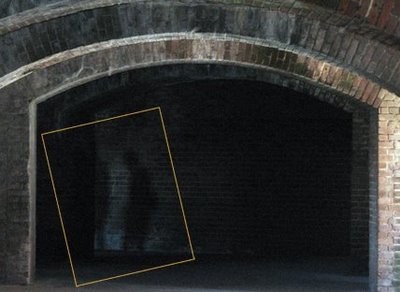 Both volunteers and visitors to the fort have reported seeing soldiers in the yard at dusk during the lowering of the flag. Cold spots and battery drain have also been reported. One theory suggests that ghosts draw the energy from their surroundings in an attempt to manifest themselves. When energy is drawn from the air, the result is a cold spot and if energy is drawn from an external source, like that of a camera battery, the result is battery drain.
Both volunteers and visitors to the fort have reported seeing soldiers in the yard at dusk during the lowering of the flag. Cold spots and battery drain have also been reported. One theory suggests that ghosts draw the energy from their surroundings in an attempt to manifest themselves. When energy is drawn from the air, the result is a cold spot and if energy is drawn from an external source, like that of a camera battery, the result is battery drain.Hundreds of dedicated military personnel served at Fort Zachary Taylor when it was in use. Perhaps their undying sense of duty binds them to the fort even in death, occasionally trying to make their presence known to the living. Just be on guard when visiting this haunt. Who knows? A ghost may point out some long-hidden treasure or even a body or two!
The post Ghostly Sentries Stand Guard appeared first on Trina Spillman Author.
Gaslighting

gas·light
/ˈɡaslīt/
verb
gerund or present participle: gaslighting
manipulate (someone) by psychological means into questioning their own sanity.
Have you ever wondered where the term gaslighting comes from? I wondered about this term shortly after seeing the 1944 movie staring Charles Boyer and Ingrid Bergman. This was also Angela Landsbury’s debut film. The movie is a classic, but for those unfamiliar with the plot, the following is an excerpt from Wikipedia that does a great job describing the film. Pay close attention to the use of the gaslight, which was the way people lit their homes back in the day, and you will discover the truth behind the term.
debut film. The movie is a classic, but for those unfamiliar with the plot, the following is an excerpt from Wikipedia that does a great job describing the film. Pay close attention to the use of the gaslight, which was the way people lit their homes back in the day, and you will discover the truth behind the term.
“World-famous opera singer Alice Alquist has just been murdered at her home, No.9 Thornton Square. The perpetrator left without the jewels, for which he had killed her, after being interrupted by Paula, Alice’s fourteen-year-old niece. Paula had been raised by her aunt Alice following her mother’s death. After Alice was murdered, Paula was sent to Italy to train to become an opera star herself.
Years later, an adult Paula (Ingrid Bergman) meets and marries Gregory Anton (Charles Boyer) after a two-week-long whirlwind romance. At his insistence, Paula returns to London, where she has no friends, to live in the long-vacant London townhouse of her deceased aunt Alice. To help calm her anxieties, Gregory suggests that they store all of Alice’s furnishings in the attic. Before they do, Paula discovers, in an old book, a letter addressed to her aunt by a man named Sergis Bauer. Gregory’s reaction is violent. However, he dismisses his outburst as one of frustration at the bad memories his bride is experiencing.
After Alice’s belongings are locked away in the attic, events take a turn for the bizarre. At the Tower of London, Paula loses an heirloom brooch that Gregory had given her, despite its having been stored safely in her handbag. A picture disappears from the walls of the house; and Gregory says that Paula took it, one of many instances of her removing and hiding things. But Paula has no recollection of having done so. Paula also hears footsteps coming from the sealed attic, and sees the gaslights dim and brighten for no apparent reason. Gregory suggests that these things exist only in her imagination. Gregory isolates his wife from the outside world, implying that he is doing so for her own good, because her nerves have been acting up, causing her to become a kleptomaniac. He is also jealous and accusatory whenever others express an interest in her. When Gregory does take her out to a friend’s house, he shows Paula his watch-chain, from which his watch has mysteriously disappeared. When Gregory conveniently finds it in her handbag, Paula becomes hysterical in front of all the guests, and Gregory takes her home. Paula begins to believe she should not go out in public. A young maid, Nancy (Angela Lansbury), worsens the situation, as Paula becomes convinced that Nancy loathes her. Gregory secretly flirts with the maid and tells Paula that she is paranoid and is imagining the maid’s disdain.
 Paula does not know that her husband is really Sergis Bauer, her aunt’s murderer. He sought out Paula in Italy with the aim of getting back into the house for Alice’s jewels. He has been secretly rummaging through Alice’s belongings in the attic to find the jewels which he is certain are still there. The footsteps Paula heard in the attic were actually his. The flickering gaslights which he claims she has imagined were caused by his turning on the attic lights, thus reducing the gas to the downstairs lights. The kleptomania exhibited by Paula is all sleight-of-hand by Gregory.
Paula does not know that her husband is really Sergis Bauer, her aunt’s murderer. He sought out Paula in Italy with the aim of getting back into the house for Alice’s jewels. He has been secretly rummaging through Alice’s belongings in the attic to find the jewels which he is certain are still there. The footsteps Paula heard in the attic were actually his. The flickering gaslights which he claims she has imagined were caused by his turning on the attic lights, thus reducing the gas to the downstairs lights. The kleptomania exhibited by Paula is all sleight-of-hand by Gregory.
Gregory does everything in his power to convince his wife that she is going mad, hoping to have her institutionalized, giving him power of attorney over her, and allowing him to search unabated for the jewels. The plan almost works. Paula is saved by her trip to the Tower of London, as it also leads to a chance encounter with Inspector Brian Cameron of Scotland Yard (Joseph Cotten), an admirer of Alice Alquist since childhood. Seeing Paula rekindles Cameron’s interest in the cold case murder of Alice and her royal jewels that were never found. With the aid of the police, Cameron figures out that Gregory slips into a vacant house next door and enters his own attic via a skylight. Cameron eventually gets inside the house to see Paula and confirms that the gaslights are indeed flickering, and she discovers the letter from Bauer that Gregory had told her was a figment of her imagination.
That same evening, Gregory at last discovers the jewels hidden in plain sight, disguised as costume jewelry. He returns to the house to discover that Paula has apparently been visited by another man. Though he knows that he has been discovered, he convinces the still-confused Paula that everything is in her imagination. However, Cameron appears in the doorway behind and arrests him with the help of police. Paula, finally convinced of her own sanity, indulges herself in a bit of revenge. She taunts Gregory, who is now bound to a chair but still trying to manipulate her, suggesting that she might cut him free so that he can escape justice. She muses that the knife in her hand might not be real, before calling in Cameron to take him away.
Gaslighting is a common ocurance, but for those who are aware, it is very hard to pull the wool over their eyes. These are the people that need to unite and say, “Hey, wait a minute, I saw the damn light flicker, you bastard!”
The post Gaslighting appeared first on Trina Spillman Author.
May 10, 2020
Ghost Train

The Labor Day Hurricane of 1935 was a deadly Category 5 storm that left death and destruction in its wake. The intense hurricane caused extreme damage in the upper Florida Keys. Craig Key, Long Key, and Upper Matecumbe and Lower Matecumbe Keys suffered the worst. In this area, hundreds of bodies were caught in wreckage and mangrove thickets along the shore. Three days after the storm, corpses had swelled and split open in the subtropical heat. Public health officials ordered plain wood coffins holding the dead to be stacked and burned in several locations.
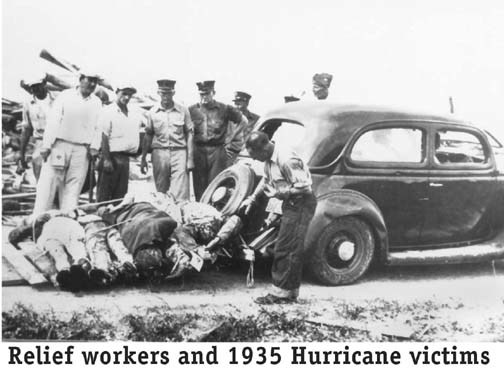
In total, at least 423 people were killed by the hurricane. Bodies were recovered as far away as Flamingo and Cape Sable on the southwest tip of the Florida mainland. In a fortunate coincidence, about 350 of the 718 veterans living in the Keys work camps were in Miami to attend a Labor Day baseball game when the storm hit. If not for this outing, many more of the men, whose barracks in the Keys were flimsy shacks, would surely have been killed by the storm.
Veterans Stranded and Hemingway Comments

Many veterans were not so lucky. The main transportation route linking the Florida Keys to mainland Florida was a single railroad line, the Florida Overseas Railroad portion of the Florida East Coast Railway. An evacuation train was sent from Homestead to rescue a group of World War I veterans, but the train was washed off the track soon after reaching the stricken area. The train was trying to rescue 683 World War I veterans in a rehabilitation camp, of which around 250 died as a result of the hurricane. The veterans, a remnant of the Bonus Army that marched on Washington, were employed for highway construction in the federal work relief project and were building a new road bridge in the upper Keys. The federal government had an arrangement with the Florida East Coast Railway to provide a train to evacuate the men. However, due to miscommunication between the government and the railway, government officials believed that a train could be readied and sent to the Keys from mainland Florida more quickly than was the case. An official investigation conducted by Aubrey W. Williams cleared those responsible of any wrongdoing, categorizing the tragedy as “an unfortunate act of God”.
Hemingway
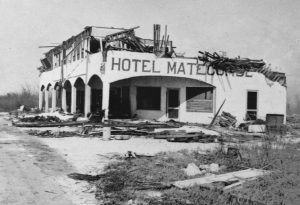
Ernest Hemingway, who toured the Matecumbes two days after the storm, harshly blamed the government for the men’s death and in the September 17, 1935 issue of The New Masses magazine he wrote, “You’re dead now brother, but who left you there in the hurricane months on the Keys where a thousand men died before you when they were building the road that’s washed out now? Who left you there? And what’s the punishment for manslaughter now?”
The destroyed railroad was never rebuilt, but temporary bridges and ferry landings were constructed as soon as materials arrived. Within a few years, a roadway, the Overseas Highway, linked the entire Keys chain to mainland Florida. But not even ripping up the tracks of the railway could stop the doomed transport train from trying to complete its mission.
Ghost Train
Several residents have reported the rumblings and whistle of a train on tracks long gone. One local man recounts an incident that still causes a shiver to race down his spine some 40 years later. He recalls as a boy of 12 deciding to head down to his favorite fishing spot. He grabbed his pole and headed out. His younger brother wanted to join him and asked if he could come along. Tommy couldn’t say no to his little brother and the two boys headed off to the old abandoned railroad bridge.
It didn’t matter though, the fish the boys were after gathered near the pilings closest to the shore. The fish were biting and the boys were busy reeling in one catch after another. Bruised clouds gathered in the distance. Flashes of lightning soon filled the air. The smell of ozone hung around the boys and they knew they were in trouble. The two brothers had barely enough time to reel in their lines before the skies opened and claps of thunder boomed and rolled across the sky. Lightning began to strike all around them and desperately seeking refuge from the fury of the storm the two boys crawled under the railroad bridge that once carried Flagler’s train from Homestead to Key West.
The Storm Raged
As the storm intensified the boys scurried further back into the recess where the bridge and shoreline met. As the storm’s winds whipped and howled through the steel trusses of the bridge, the boys heard a distant rumbling. At first they thought it was thunder, but the noise grew louder and the bridge began to vibrate.
“Tommy what is it!”
“I don’t know I can’t see anything.”
Tommy peered out from beneath the bridge just in time to catch a glimpse of a roaring locomotive, its bright head light piercing the gloom of the storm. Over the claps of thunder a high pitched whistle alerted the boys of its presence.
“Tommy, what’s a train doing on this bridge? It’s gonna crash!”
Frantic, Tommy knew he had to stop the train before it plummeted into the ocean but couldn’t emerge from the shelter of the bridge or he would be struck by lightning. The train continued down the tracks and the boys could do nothing but sit in horror awaiting the inevitable crash. The rumbling grew louder, the train whistle blasted, the boys covered their ears and squeezed their eyes shut and then all of a sudden, there was silence. The storm had moved on and there was no sign of the train. It was as if the train had vanished into thin air. Perhaps the residual energy stored in the bridge replays the events of that fateful day like a macabre movie stuck in a perpetual loop.
The post Ghost Train appeared first on Trina Spillman Author.
May 6, 2020
Things that go Bump in the Night
 In conducting research for my book, Florida Frights: Ghosts of the Keys, I stumbled upon an interesting statistic; over half of the adult population in the United States believes in ghosts. Why do so many of us believe in the paranormal? Does it bring us comfort to think that the human soul can survive after death making us in some way immortal? Does this belief have roots in science? Yes, there is science to back up this claim. The first law of thermodynamics, also known as the Law of Conservation of Energy, states that energy can neither be created nor destroyed; energy can only be transferred or changed from one form to another. This law has always begged the question that if humans are comprised of energy, where does this energy go after we die? Is it merely absorbed into our surroundings? Or, does it stay in tact, enabling us to recall thoughts and memories from multiple lifetimes? Can human energy become trapped, resulting in what is commonly referred to as spirits, or ghosts?
In conducting research for my book, Florida Frights: Ghosts of the Keys, I stumbled upon an interesting statistic; over half of the adult population in the United States believes in ghosts. Why do so many of us believe in the paranormal? Does it bring us comfort to think that the human soul can survive after death making us in some way immortal? Does this belief have roots in science? Yes, there is science to back up this claim. The first law of thermodynamics, also known as the Law of Conservation of Energy, states that energy can neither be created nor destroyed; energy can only be transferred or changed from one form to another. This law has always begged the question that if humans are comprised of energy, where does this energy go after we die? Is it merely absorbed into our surroundings? Or, does it stay in tact, enabling us to recall thoughts and memories from multiple lifetimes? Can human energy become trapped, resulting in what is commonly referred to as spirits, or ghosts?
How Many Believe?
 According to a recent poll conducted by Youpoll.com at the end of October 2019, a partisan divide in the US emerges when it comes to the belief in things that go bump in the night. The poll found:
According to a recent poll conducted by Youpoll.com at the end of October 2019, a partisan divide in the US emerges when it comes to the belief in things that go bump in the night. The poll found:
Republicans are more likely than Democrats to believe in supernatural entities of all kinds, particularly demons. Over half (54%) of Republicans say that they believe in demons, while far fewer (37%) Democrats say the same. Similarly, Republicans are more likely than Democrats to believe in ghosts (46% vs 41%), vampires (14% vs 8%) and other supernatural beings (50% vs 41%).
With 45 percent of Americans expressing a belief in ghosts, perhaps it’s unsurprising that many Americans also believe that ghosts and spirits can come back to haunt certain places on Earth. About four in 10 (43%) US adults say they think ghosts can come back and haunt people or places. Women (51%) are more likely than men (35%) to hold this belief.
More than one-third of Americans (36%) say that they have personally felt the presence of a spirit or ghost. Once again, women (41%) are more likely than men (31%) to say that this has happened to them. Just over one in ten (13%) Americans say that they have communicated directly with a ghost or spirit of someone who has died.
While modern science can neither prove nor disprove the existence of ghosts, one thing is certain, there are strange phenomena that exist in our universe that cannot be explained and warrant further examination.
Searching for Answers
Many have made it their life’s work to explore claims of the paranormal. I have interviewed many of these “ghost hunters” and have uncovered some interesting theories based on their paranormal research. For example, spirits no longer possess a physical body therefore these entities don’t require food or sleep to exist in our universe. What do they need? Energy. If a ghost or a spirit is pure energy and stands next to a piece of equipment that
 monitors changes in energy then perhaps it is possible to communicate with these entities using such devices. Many ghost hunters have experienced fluctuations in energy fields during the course of their investigations. It has been my experience that spirits aren’t that different from the living. Some are mischievous, some angry and there are those who may not even know they’re dead, bound to this plain out of an eternal sense of duty. Haunted location fascinate me and are beacons when I travel. It isn’t hard to imagine that the energy of earthbound spirits remains in many of the locations I have visited. From the dark energy surrounding the doll known as Robert (for details on that haunt check out the blog post, “Oh that Voodoo that You Do”), to the peaceful energy surrounding the ghost of Helen. One thing’s certain; things do go bump in the night that can’t be explained.
monitors changes in energy then perhaps it is possible to communicate with these entities using such devices. Many ghost hunters have experienced fluctuations in energy fields during the course of their investigations. It has been my experience that spirits aren’t that different from the living. Some are mischievous, some angry and there are those who may not even know they’re dead, bound to this plain out of an eternal sense of duty. Haunted location fascinate me and are beacons when I travel. It isn’t hard to imagine that the energy of earthbound spirits remains in many of the locations I have visited. From the dark energy surrounding the doll known as Robert (for details on that haunt check out the blog post, “Oh that Voodoo that You Do”), to the peaceful energy surrounding the ghost of Helen. One thing’s certain; things do go bump in the night that can’t be explained.
May 5, 2020
A Tribute to Mom
The ancient Greeks and Romans were the first to hold festivals to honor the mother goddesses Rhea and Cybele. But the history of Mother’s Day stems from the early Christian festival, “Mothering Sunday,” which honored mothers in the United Kingdom and parts of Europe. Originally seen as a time when the faithful would return to their “mother church”, “Mothering Sunday” fell on the fourth Sunday in Lent. Over time, the day became more secular and children gave their mothers flowers and other tokens of appreciation.
 US Origins
US OriginsThe origins of Mother’s Day in the United States dates back to the 19th century. Leading up to the Civil War, Ann Reeves Jarvis, of West Virginia, formed “Mothers’ Day Work Clubs.” These clubs taught local women how to properly care for their children, and later became a unifying force following the Civil War. In 1868, Jarvis organized “Mothers’ Friendship Day” to honor mothers of former Union and Confederate soldiers that had died during the war. She organized this event in hopes of promoting reconciliation. Following Ann Reeves Jarvis’ death in 1905, her daughter, Anna Jarvis made it her mission to honor her mother’s life.

Commercialization Ruins Another Holiday
Anna organized her first Mother’s Day celebration, with the help of a Philadelphia department store owner by the name of John Wanamaker, at a Methodist church in Grafton, West Virginia. On the same day, thousands of people attended a Mother’s Day event at one of the Philadelphia department stores. The success of the event galvanized Anna to see her holiday added to the national calendar. Arguing that American holidays were biased toward male achievements, she started a massive letter writing campaign to adopt a day honoring motherhood. Her persistence paid off. In 1914, President Woodrow Wilson signed a measure officially establishing the second Sunday in May as Mother’s Day.
Anna Jarvis had originally conceived of Mother’s Day as a day of personal celebration between mothers and families. White carnations honored deceased mothers, and pink carnations honored living mothers. Once Mother’s Day became a national holiday, florists, card companies and other merchants capitalized on its popularity.
 Jarvis initially worked with the floral industry to help raise awareness about this new holiday honoring mom. But by 1920, Anna had become disgusted with how the holiday had become commercialized. Jarvis eventually led a campaign against Mother’s Day. She despised the commercialization of the day and would wind up spending her life’s fortune on legal fees. In an ironic twist, Anna left this world with no children of her own to honor her memory.
Jarvis initially worked with the floral industry to help raise awareness about this new holiday honoring mom. But by 1920, Anna had become disgusted with how the holiday had become commercialized. Jarvis eventually led a campaign against Mother’s Day. She despised the commercialization of the day and would wind up spending her life’s fortune on legal fees. In an ironic twist, Anna left this world with no children of her own to honor her memory.
We may not be able to hold mom this Mother’s Day, know that moms always hold us… in their hearts.
The post A Tribute to Mom appeared first on Trina Spillman Author.
May 3, 2020
Oh That Voodoo That You Do

When…
This tale begins in 1896 at the Key West home of Mr. And Mrs. Thomas Otto. The Otto’s were cruel people and had a reputation of mistreating their servants. One servant, a Bahamian maid well versed in the ways of voodoo, took care of the couple’s young son, Robert Eugene Otto (Gene). One day she decided to get back at the Otto family for her mistreatment and presented four-year-old Gene with a cursed doll named Robert. The straw stuffed toy stood three feet tall and bore an amazing resemblance to Gene.
Robert and Gene became constant playmates, but soon, Gene realized Robert was more than a doll. He was alive and filled with an evil energy. Gene often spoke to Robert, but when a sinister entity started answering the young boy, the Otto’s became increasingly concerned, especially when strange things began to happen.
Robert seemed to enjoy terrifying the neighbors by running about the house in front of the windows when the family was gone. The Otto’s could hear small slippered feet scampering across the second story floorboards, accompanied by gruesome giggles, in the wee hours of the night.
Gene, paralyzed from the night terrors inflicted by Robert would scream in terror as he huddled at the head of the bed with Robert glaring at the terrified little boy. Upon entering their son’s room, they would find furniture tossed about like so many play things, and every time, in a stammering voice, Gene would exclaim, “Robert did it!” Soon, the doll was exiled to the attic.
Here Comes the Bride…
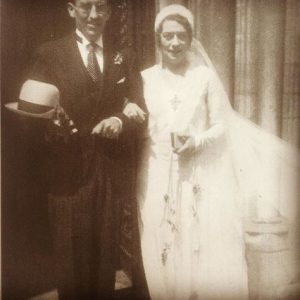 When Gene’s parents died, Gene inherited the family home and soon rediscovered his old friend. Soon, Robert’s hold on Gene became terrifyingly strong. As an adult, Gene became a celebrated artist in Key West and his fame and wealth grew. Gene married and he and his new bride Anne, moved into the family home where Gene’s wife quickly came to dislike the doll known as Robert. In fact, she was so fearful that when she looked at him she would flee the room in horror.
When Gene’s parents died, Gene inherited the family home and soon rediscovered his old friend. Soon, Robert’s hold on Gene became terrifyingly strong. As an adult, Gene became a celebrated artist in Key West and his fame and wealth grew. Gene married and he and his new bride Anne, moved into the family home where Gene’s wife quickly came to dislike the doll known as Robert. In fact, she was so fearful that when she looked at him she would flee the room in horror.
Anne could not understand Gene’s obsession with the doll. Nevertheless, because she loved her husband she humored him and even gave Robert his own room, once again, in the attic. One day Gene told his wife that Robert was very unhappy and demanded a room with a view. Anne questioned her husband, “The doll is demanding a room with a view?”
Over his wife’s objections, Gene moved Robert out of the attic down to the turret room. Robert sat at the window overlooking the street. Children on their way to school reported seeing him moving about the room glaring down at them. Inside the house, Gene became increasingly irrational and violent. He often lashed out in fits of rage, throwing things and striking out at his wife. Every time he would say the same thing, “It was Robert.”
The Turret Room…

One day a plumber, working alone in the turret room, fled the house in terror. When asked why, he said he had heard Robert giggling, but there was nothing happy or joyous about the sounds coming from the doll. The sounds were wicked, evil noises that grated on the poor man like fingers scratching a chalkboard.
Gene became increasingly despondent over the next few years. One day, out of the blue, he locked himself in the turret room and died, with Robert at his side. Anne fled the house leaving the doll behind in the attic. Instead of selling her husband’s family home, she decided to lease it and in the lease stipulated that Robert be the sole occupant of the attic.
The 10-year-old daughter of the new tenants soon discovered Robert, and once again, horrible things began to happen. One evening the little girl ran into her parent’s bedroom hysterical, claiming the doll tortured her. The little girl’s parents often heard footsteps in the attic but did not mention this to their daughter for fear of scarring her. They believed their daughter and knew in their hearts that the doll was evil. The little girl, now an adult, steadfastly claims, “the doll was alive and wanted to kill me.”
If you want to visit Robert, you can…
Robert, still dressed in his white sailor’s suit, clutching his stuffed lion, lives quite comfortably, though well guarded, at the Key West Martello Museum.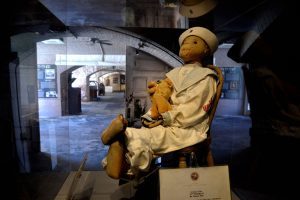
When Robert first arrived at his current home in the museum he was not in an enclosure and on several occasions, the museum staff would find Robert in a different position, even a different location, than where they had left him the night before. His feet have been covered in dirt and dust as if he had been running around the museum all night.
Robert takes on different expressions and makes certain people feel lightheaded when they are near the case. Is this the result of a manipulation of energy? One museum employee wanted to take a picture of Robert and went to remove his hat. He reports the doll looked angry. The employee removed the hat and tried to take the picture, but his camera would not work. When he replaced the hat, the camera immediately clicked off four pictures.
Robert currently resides behind glass, a jail of sorts, keeping him out of mischief. Near his case hangs a sign warning visitors that taking Robert’s picture without asking his permission first, can result in damaged film and cameras. Unfortunate accidents have also been blamed on Robert, including one man visiting from Buffalo, NY who refused to ask Robert’s permission before snapping his picture and upon his return home, dropped dead.
According to reports, Robert still haunts the attic of the Artist’s House, as does Anne’s spirit, forever trapped with Robert, proving, “Be careful of the objects you possess or one day they may wind up possessing you”.
The post Oh That Voodoo That You Do appeared first on Trina Spillman Author.
Mango & Jalapeno Frozen Margaritas

Mangos rain down from a fruit ladened tree in my backyard and I thought, what better way to celebrate Cinco de Mayo than with a yummy Mango Margarita. The added benefit, you won’t care that you’re stuck at home listening to your neighbor’s kids screaming with glee from their backyard, every… single… day. Cheers!
Ingredients:
8 ounces of your favorite Tequila
6 ounces Triple Sec
3 cups diced mango
4 tablespoons cilantro (plus 4 sprigs for garnishing)
1 whole, fresh jalapeno, sliced (plus 1 additional sliced jalapeno for garnish)
Juice from 3 large limes
1 additional lime, cut in wedges
3 tablespoons sugar
1/3 cup water
Large ice cubes
Kosher salt
Directions:
Combine mangos, water and sugar into a saucepan on medium heat.
Bring to a boil, stirring occasionally, until mangos are reduced and mixture is thick.
Pour into a glass or ceramic dish and let stand.
Using a mortar and pestle (or a ceramic bowl and wooden spoon), muddle the cilantro, jalapeno and lime wedges.
Spoon (and “scrape”) half of this mixture and add to a tumbler/shaker. Add 1/2 the mango mixture, 1/2 the lime juice, 4 ounces Tequila, 3 ounces
Triple Sec, and a heaping helping of ice to the tumbler/shaker.
Shake vigorously while singing one rendition of “Feliz Cinco de Mayo a mi”.
Rim two glasses with a lime wedge, flip each glass over onto a small pile of kosher salt (or sugar) to coat the rims. Add ice to each glass.
Strain the margarita mixture into each glass.
Garnish with a jalapeno slice and a cilantro sprig. Enjoy not caring as much that you are stuck at home!
The post Mango & Jalapeno Frozen Margaritas appeared first on Trina Spillman Author.
April 28, 2020
Hurricanes are Expensive

What’s a $400 Emergency Called?
Statistics indicate most Americans live pay check to pay check and don’t have enough in savings to cover a $400 emergency. Guess what a $400 emergency is called? As hurricane season approaches it is time to revisit hurricane Dorian.
When Dorian hit I was scrambling to have enough money to cover my normal bills while having enough left over to buy supplies for a hurricane that may or may not hit south Florida. That’s the rub, isn’t it? If you take a risk and don’t prepare for a catastrophic category 4 or 5 hurricane, you could die if the worst case scenario of landfall plays out. Best case scenario, the storm passes. So that’s the gamble, prepare for a potentially catastrophic storm you really can’t afford, or take a chance and hope for the best.
To Prepare or Not Prepare, that is the question…
If you think about what you need to prepare for a storm, it adds up: gasoline for your vehicles and generator; non perishable food items; ice if you don’t have a generator to keep your refrigerator running; batteries for flash lights and fans if the power goes out; plywood for the windows that don’t have hurricane shutters; zip ties and bungee cords because you can’t find the one’s from the last hurricane; house repairs, especially leaky roofs; home insurance; tarps; sandbags; and storage fees for any recreational vehicles that may get tossed about like a child’s toy in high winds. And to make matters worse during the upcoming 2020 hurricane season is the inability to stack up due to the current pandemic. Check out this article from the Miami Herald for details.
Hurricane Kits
It is important to create a kit of supplies that you could take with you if you are forced to evacuate. This kit will also be useful if you are able to stay in your home, but are still affected by the storm, such as through the loss of power. One common trend seen when hurricanes are approaching is a wide-spread panic. When this happens, people rush in large numbers to get all the supplies they think they need. However, if you prepare your kit ahead of time, you can alleviate a lot of the potential stress of a very chaotic situation. You should create your kit in a bag that you can easily take with you. Check out the state of Florida’s hurricane website for more information about how to stay safe this hurricane season. Some recommended items to include are:
Non-perishable food (enough to last at least 3 days)
Water (enough to last at least 3 days)
First-aid kit (include any prescription medication you may need)
Personal hygiene items and sanitation items
Flashlights (have extra batteries on hand)
Battery operated radio (again, have extra batteries)
Waterproof container with cash and important documents
Manual can opener
Lighter or matches
Books, magazines, games for recreation
Special needs items: pet supplies and baby supplies if applicable
Cooler and ice packs
A plan for evacuation and for if family members are separated
The intensification of hurricanes like Dorian will likely continue as our planet experiences climate change. The storms will have devastating economic costs associated with them. We might be able to reverse course, but humans don’t like change, particularly if that change results in a perceived inconvenience. Here’s the rub, Mother Nature doesn’t give a damn if we believe in climate change or not, and God help the human race when she decides to make believers out of us.

Mother Nature Doesn’t Care if you Believe or Not
The post Hurricanes are Expensive appeared first on Trina Spillman Author.




